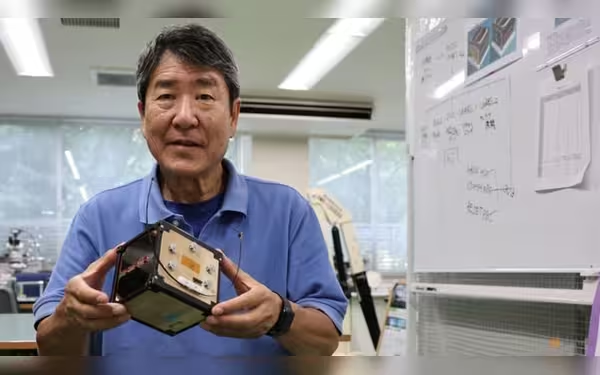Thursday, November 7, 2024 03:38 AM
Japan Launches World's First Wooden Satellite LignoSat
- LignoSat is the first wooden satellite launched into space.
- Developed by Kyoto University and Sumitomo Forestry.
- Aims to explore sustainable materials for future space missions.
 Image Credits: channelnewsasia
Image Credits: channelnewsasiaJapan successfully launches LignoSat, the world's first wooden satellite, exploring sustainable materials for future space missions.
In a groundbreaking development for space exploration, Japanese researchers have successfully launched the world's first wooden satellite, named LignoSat. This innovative satellite was sent into space on November 5, as part of an early test to explore the use of timber in future missions to the Moon and Mars. The project is a collaboration between Kyoto University and Sumitomo Forestry, aiming to demonstrate the potential of renewable materials in the harsh environment of space.
LignoSat, which is about the size of a palm, will be transported to the International Space Station (ISS) aboard a SpaceX mission. Once it reaches the ISS, it will be released into orbit approximately 400 kilometers above the Earth. The satellite is named after the Latin word for "wood" and is designed to showcase how wood can be utilized in space, particularly as humanity looks to establish a presence beyond our planet.
Takao Doi, an astronaut and researcher at Kyoto University, expressed optimism about the future of timber in space exploration. He stated, "With timber, a material we can produce by ourselves, we will be able to build houses, live and work in space forever." This vision aligns with a 50-year plan to plant trees and construct wooden houses on the Moon and Mars, highlighting the potential for sustainable living in outer space.
To validate the feasibility of using wood in space, Doi's team developed a NASA-certified wooden satellite. Professor Koji Murata, a forest science expert at Kyoto University, noted that early airplanes were made of wood, suggesting that a wooden satellite is indeed possible. He further explained that wood is more durable in space than on Earth, as the absence of water and oxygen prevents it from rotting or catching fire.
One of the significant advantages of a wooden satellite is its reduced environmental impact at the end of its life cycle. Traditional metal satellites must re-enter the Earth's atmosphere to avoid becoming space debris, which can create harmful aluminum oxide particles. In contrast, wooden satellites would simply burn up upon re-entry, resulting in less pollution.
Doi also mentioned the possibility of metal satellites being banned in the future, emphasizing the importance of proving the functionality of their wooden counterpart. The researchers identified honoki, a type of magnolia tree native to Japan, as the most suitable material for spacecraft after conducting a 10-month experiment aboard the ISS.
LignoSat is crafted from honoki using traditional Japanese techniques that do not involve screws or glue. Once deployed, it will remain in orbit for six months, during which its electronic components will monitor how wood withstands the extreme conditions of space, where temperatures can swing from -100 to 100 degrees Celsius every 45 minutes.
Additionally, LignoSat will assess wood's ability to shield semiconductors from space radiation, which could have implications for future data center construction. Kenji Kariya, a manager at Sumitomo Forestry Tsukuba Research Institute, remarked, "It may seem outdated, but wood is actually cutting-edge technology as civilization heads to the moon and Mars." He believes that expanding into space could revitalize the timber industry.
The launch of LignoSat marks a significant step forward in the quest for sustainable materials in space exploration. As humanity prepares for future missions to the Moon and Mars, the use of renewable resources like wood could pave the way for a more environmentally friendly approach to living and working beyond Earth. This innovative project not only showcases the potential of timber in space but also encourages a broader conversation about sustainability in all aspects of our lives.












